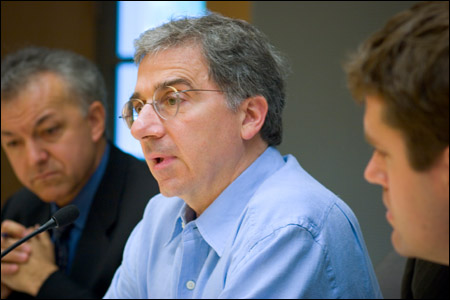|
From rxpgnews.com Stem Cell Research
After more than two years of intensive ethical and scientific review, Harvard Stem Cell Institute (HSCI) researchers at Harvard and Children's Hospital Boston have been cleared to begin experiments using Somatic Cell Nuclear Transfer (SCNT) to create disease-specific stem cell lines in an effort to develop treatments for a wide range of now-incurable conditions afflicting tens of millions of people.
Somatic Cell Nuclear Transfer involves removing nuclei, which contain the cellular DNA (genes) from egg cells, and replacing them with the nuclei of donor cells. The resulting cell is subject to a chemical, or electrical, charge that triggers cell division and the creation of an embryo genetically identical to the donor of the nuclei. In the HSCI experiments, aimed at understanding diseases, the nuclei will be taken from skin cells donated by patients suffering from diabetes, blood diseases, and neurodegenerative diseases. Research involving human embryonic stem cells is controversial because extracting the cells - which can differentiate into any cell or tissue type in the body - requires the destruction of a human embryo, albeit a blastocyst of only a few hundred cells, literally half the size of the period at the end of this sentence. Melton, in collaboration with Kevin Eggan and Douglas Powers of Boston IVF , has already created 31 stem cell lines using left-over frozen embryos donated by couples who went through in vitro fertilization (IVF), and has distributed those stem cell lines to scientists around the world. Embryonic stem cells are the master cells of the body, capable of developing into any tissue type. The researchers will seek to learn how to control that differentiation, with a goal of eventually creating lines of cells that can, for instance, produce insulin-making islet cells in the pancreas, which are depleted or absent in diabetics. Melton and Eggan's first nuclear transfer experiments will attempt to create diabetes specific stem cells by removing the nuclei from skin cells taken from diabetic volunteers at the Naomi Berrie Diabetes Center at Columbia University Medical Center and inserting them into donor eggs from which the nuclei have been removed. In addition to collaborating with Melton on this project, Eggan, whose work is supported by the Stowers Medical Institute, is seeking approvals to study diseases of the nervous system. Children's Hospital researcher and HSCI Executive Committee member George Daley explains that the ultimate goal of all three HSCI researchers, once they understand how embryonic stem cells are programmed to differentiate into specific cell types, is to literally move a patient's disease into a petri [laboratory] dish. "We plan to take skin cells from a patient with a genetic disease, like sickle cell anemia or any one of more than 40 bone marrow disorders, and reprogram that skin cell back to its embryonic state. We can then study the disease using these cells, correct their genetic defects and coax the repaired cells to become normal blood cells. Our ultimate goal is to return the repaired cells to the patients." Egg donation and reimbursement Research using human embryonic stem cells is ineligible for federal funding, including grants from the National Institute of Health; only private money may be used to support SCNT research. Under the protocol approved by the Institutional Review Board (IRB) of Harvard's Faculty of Arts and Science, and the IRB of Boston IVF, where the ova will be collected for Melton and Eggan's work, donors will not be paid. The committees struggled to ensure not only that potential donors would understand all potential risks associated with ova donation, but would also understand that they will be contributing to basic science experiments, and that it will be many years - at best - before patients benefit directly from the work. Speaking of the IRB decisions at Harvard, Children's Hospital, Boston IVF, Brigham and Women's Hospital - where Daley is obtaining ova for his experiments - and Columbia University allowing the Harvard Stem Cell Institute SCNT work to proceed, Melton says, "I think Harvard University has done the right thing by giving this research very careful review by multiple boards, and allowing plenty of time for reconsideration and reflection. All rights reserved by www.rxpgnews.com |
